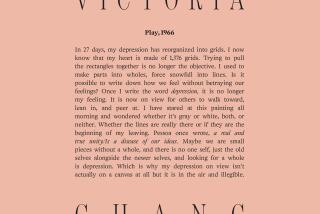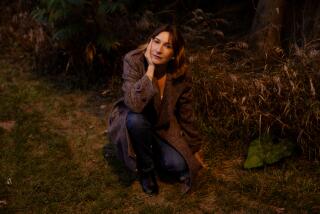‘The Pattern in the Carpet: A Personal History With Jigsaws’ by Margaret Drabble
The Pattern in the Carpet
A Personal History With Jigsaws
Margaret Drabble
Houghton Mifflin Harcourt: 368 pp., $25
“These fragments I have shored against my ruins,” T.S. Eliot wrote in “The Waste Land.” In “The Pattern in the Carpet,” Margaret Drabble uses the jigsaw puzzle, its history and its pieces, as her own fragments assembled against the ruins of depression.
Ostensibly set out as a history of jigsaws and her experience with them, Drabble’s mini-project wavers between the meticulously detailed and the desultory, broken up by all manner of feverish digressions. Like birds that flutter-dance away from their nests, at once concealing and revealing them, Drabble lets us glimpse shards of acutely depressive pain through the feverish scrim of her jigsaw puzzle elaborations and far-afield detours.
The glimpses of memoir are a play of light and dark. The light is Drabble’s account of her Aunt Phyl, a teacher whose warmth and playfulness stood in contrast with the dry intellectual snobbishness of her parents, mainly her mother.
Drabble would spend vacations with Phyl at Bryn, a house on the Great North Road that Phyl ran as a part-time bed-and-breakfast. In a child raised in constricted spareness in Yorkshire, the hum of traffic outside, the brief eruption of travelers on their way to a magically imagined Somewhere, aroused a sense of romance and movement. Aunt Phyl, tart yet with a childlike sense of fun, was a fount of games (including puzzles) and expeditions. Drabble’s account of visiting London with her as a child wonderfully paints the expansive allure of the city. It is one of her book’s freest and most pleasurably tactile passages. Its counterpart are the excursions that Drabble, grown up, took Phyl on when her aunt was in her 70s and 80s.
Darkness pervades the other bits of memoir. Drabble writes of her parents as if in a frozen state from which she still remains unthawed. A reference to her sister, the novelist A.S. Byatt, preserves the rancor that has long existed between these literary rivals. She draws a dolorous picture of the cancer afflicting her second husband, the biographer Michael Holroyd, with long confinement in hospitals and home and a diet whose bland whiteness suggests an endless arctic winter. And she writes of her own depressions, verging at one point on the suicidal.
They are of the order of Gerard Manley Hopkins’ “I am gall, I am heartburn.” Drabble seems too deep in to be able to analyze them; instead she writes her jigsaws and digressions as if she were a Samaritan volunteer on the phone to herself and able to forestall disaster only as long as she keeps talking.
In her account, jigsaws go back to the 18th century when John Spilsbury drew a map of England’s counties and cut them out as squares to be scrambled and assembled. This began a vogue for so-called dissected maps used for educational purposes. Later other subjects appeared, the pictures were pasted to wood and the wood cut with a jigsaw into interlocking shapes. With a nudge to herself, Drabble notes that their popularity rose in the 1930s Depression. She writes of one all white, another displaying Jackson Pollock’s splatterfest “Convergence.” All but impossible, yet a bestseller.
Some of the jigsaw material is interesting, some labored research that seems designed to fill Drabble’s precarious inner silences more than to satisfy our curiosity. It is the digressions that most wander out of control. There are too many to list: pages about children’s games, more pages about their toys, others on the growing presence of museum shops, others about the growth of goal-racing board games (Snakes and Ladders, Parcheesi) and their origin in the 16th century Italian Royal Game of the Goose. There is dim speculation that Samuel Johnson, who loved inns, must have seen patrons playing Goose. There is a dimmer connection between jigsaws and the shifting pack ice encountered by the Antarctic explorer Ernest Shackleton.
Throughout, the recollections of Aunt Phyl and her countryside bring a restoring hopefulness. But toward the end even these grow dark. Phyl goes to a nursing home. Drabble wonders whether the golden memory of Bryn has any validity. It may be a fallacy that the past inhabits the present. “Bryn was nothing more than a house that my Bloor grandparents happened to buy,” she writes. “And the house belongs once more to strangers.”
As for Auntie Phyl, in the nursing home “she was confronting, as I was through her, the pointlessness of survival, the uselessness of all the little strategies by which we manage to stay alive and fill our time and get though our days.” Drabble pretty much tells us that “The Pattern in the Carpet” is one such strategy.
Eder, a former book critic of The Times, was awarded a Pulitzer Prize for criticism in 1987.
More to Read
The biggest entertainment stories
Get our big stories about Hollywood, film, television, music, arts, culture and more right in your inbox as soon as they publish.
You may occasionally receive promotional content from the Los Angeles Times.






